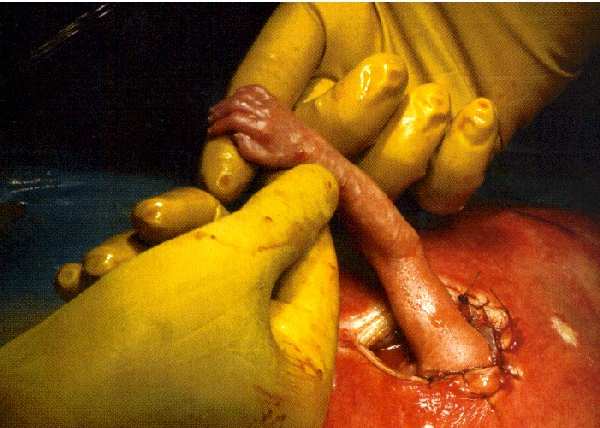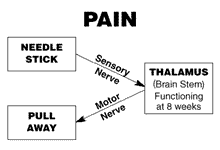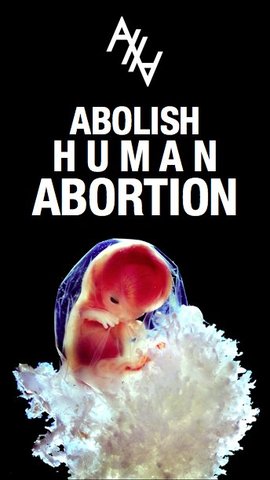Yes, every abortion kills an innocent human being. Even more alarming is the fact that beginning at the 8th week of development, an unborn baby that is aborted feels pain during the abortion. The baby feels both psychological and real physical, organic pain. Let that sink in. Of course, whether or not abortion is a painful experience to the unborn child being aborted, the child is left no less dead as a result. In talking about the question of fetal pain, we must remember that it ultimately has no bearing on the morality of abortion.
Abortion kills babies. Wait, it actually gets worse. Abortion painfully kills babies.
Abortion is difficult and painful for the unborn child. Surgeon Robert P. N. Shearin states that: [1]
As early as eight to ten weeks after conception, and definitely by thirteen-and-a-half weeks, the unborn experiences organic pain…. First, the unborn child’s mouth, at eight weeks, then her hands at ten weeks, then her face, arms, and legs at eleven weeks become sensitive to touch. By thirteen-and-a-half weeks, she responds to pain at all levels of her nervous system in an integrated response which cannot be termed a mere reflex. She can now experience pain.
President Ronald Reagan stated in 1984 that during an abortion:
The fetus feels pain which is long and agonizing.
After President Ronald Reagan said this then it set off a furious reaction by pro-choice advocates. They did not want to believe this, nor did they want the public to believe it. But twenty-six medical authorities, including two past presidents of the American College of Obstetricians and Gynecologists, stepped forward with a letter documenting that the unborn does in fact feel pain during an abortion.
Their letter says in part: [2]
Mr. President, in drawing attention to the capability of the human fetus to feel pain, you stand on firmly established ground…. That the unborn, the prematurely born, and the new-born of the human species is a highly complex, sentient, functioning, individual organism is established scientific fact…. Over the last eighteen years, real time ultrasonography, fetoscopy, study of the fetal EKG [electrocardiogram] and the fetal EEG [electroencephalogram] have demonstrated the remarkable responsiveness of the human fetus to pain, touch, and sound.
Pioneer fetologist Albert Iiley, of the University of Auckland, says that by the fifty-sixth day after conception, the baby’s spinal reflexes are sufficiently developed to feel pain. He adds: [3]
When doctors first began invading the sanctuary of the womb, they did not know that the unborn baby would react to pain in the same fashion as a child would. But they soon learned he did.
Dr. Liley’s observation is graphically demonstrated in Dr. Bernard Nathanson’s classic film, The Silent Scream, the first widely circulated ultrasound of an actual abortion. [4]
It shows a child serenely resting in her mother’s womb. Suddenly the child is alarmed because of the intruding abortion device. She moves as far away as she can, trying desperately to save her life. Just before her body is torn to pieces and sucked out through the vacuum tube, her tiny mouth opens in an unheard scream of terror. After the abortion the doctor who performed it was invited to view the ultrasound. He was so upset with what he saw that he left the room. Though he had performed over ten thousand abortions, he never performed another one. [5]
D&E, saline, and prostaglandin abortions can ALL cause pain.
Dilation and evacuation (D & E), saline, and prostaglandin abortions can all cause pain for the unborn. [6]
If unborn babies can’t feel pain then why are they given anesthesia during fetal surgery?
 Many babies now undergo fetal surgery, including Sarah Marie Switzer, whose extended arm at twenty-four weeks gestation is captured in the picture to the left. These babies are routinely given anesthesia to prevent pain during the procedure.
Many babies now undergo fetal surgery, including Sarah Marie Switzer, whose extended arm at twenty-four weeks gestation is captured in the picture to the left. These babies are routinely given anesthesia to prevent pain during the procedure.
Because of the obvious fact that late-term abortions cause pain for preborn children, a California assemblyman introduced the Fetal Pain Prevention Act of 1998, which would have required that babies be sedated to reduce their suffering in third trimester abortions.
(The Center for Disease Control indicates thirty-nine hundred of these are performed annually in California alone.)
Planned Parenthood strongly opposed the bill, which subsequently failed.
But what does it say about our society, or about Planned Parenthood or the pro-choice movement, that people would not only insist upon the killing, but refuse to require measures to reduce human suffering? These are measures that would be required by any veterinary clinic in putting to sleep a dog.
The Royal College of Obstetricians and Gynecologists, a British panel of medical and scientific experts, affirmed in October 1997 that fetal pain does exist and recommends that: [7]
Practitioners who undertake termination of pregnancy at 24 weeks or later should consider the requirements for feticide analgesia and sedation.
American medical experts also indicate that unborn children beyond 20 weeks are capable of experiencing pain, or at least react to stimuli in a manner that could be interpreted as reaction to pain. One expert, in congressional testimony, characterized the pain experienced in a partial-birth abortion procedure as a “dreadfully painful experience.” Apparently fetal surgeons agree that their patients feel pain, since anesthesia is given not only to the mother but to her child. Despite the pro-choice rhetoric, the patients/victims would not likely agree that abortion is easy or painless. [8]
Registered nurse Brenda Pratt Shafer recounts her experience watching a partial-birth abortion: [9]
I stood at a doctor’s side as he performed the partial-birth abortion procedure, and what I saw is branded forever on my mind. On the ultrasound screen, I could see the heart beating…. Dr. Haskell went in with forceps and grabbed the baby’s legs and pulled them down into the birth canal. Then he delivered the baby’s body and the arms—everything but the head. The doctor kept the baby’s head just inside the uterus. The baby’s little fingers were clasping and unclasping, and his feet were kicking. Then the doctor stuck the scissors through the back of his head, and the baby’s arms jerked out in a flinch, a startle reaction, like a baby does when he thinks that he might fall. The doctor opened up the scissors, stuck a high-powered suction tube into the opening and sucked the baby’s brains out. Now the baby was completely limp. Dr. Haskell delivered the baby’s head. He cut the umbilical cord and delivered the placenta. He threw that baby in a pan, along with the placenta and the instruments he’d used. I saw the baby move in the pan. I asked another nurse and she said it was just ‘reflexes.’ I have been a nurse for a long time and I have seen a lot of death—people maimed in auto accidents, gunshot wounds, you name it. I have seen surgical procedures of every sort. But in all my professional years, I had never witnessed anything like this.
More proof that the unborn baby feels pain by 8 weeks.
 By 8 weeks the neuro-anatomic structures are present. What is needed is (1) a sensory nerve to feel the pain and send a message to (2) the thalamus, a part of the base of the brain, and (3) motor nerves that send a message to that area. These are present at 8 weeks. The pain impulse goes to the thalamus. It sends a signal down the motor nerves to pull away from the hurt.
By 8 weeks the neuro-anatomic structures are present. What is needed is (1) a sensory nerve to feel the pain and send a message to (2) the thalamus, a part of the base of the brain, and (3) motor nerves that send a message to that area. These are present at 8 weeks. The pain impulse goes to the thalamus. It sends a signal down the motor nerves to pull away from the hurt.
 Here’s an example.
Here’s an example.
Try sticking an infant with a pin and you know what happens. She opens her mouth to cry and also pulls away.
Try sticking an 8 week old human fetus in the palm of his hand. He opens his mouth and pulls his hand away.
A more technical description would add that changes in heart rate and fetal movement also suggest that intrauterine manipulations are painful to the fetus. [10]
OK, that is activity that can be observed, but is there other evidence of pain? After all, the fetal baby can’t tell us he hurts.
Yes.
Pain can be detected when nociceptors (pain receptors) discharge electrical impulses to the spinal cord and brain. These fire impulses outward, telling the muscles and body to react. These can be measured. [11]
[12]
Lip tactile response may be evoked by the end of the 7th week. At 11 weeks, the face and all parts of the upper and lower extremities are sensitive to touch. By 13 1/2 to 14 weeks, the entire body surface, except for the back and the top of the head, are sensitive to pain.
Pain? What of just comfort?
The unborn baby not only feels pain but will maneuver himself around in the womb to a comfortable position: [13]
One of the most uncomfortable ledges that the unborn can encounter is his mother’s backbone. If he happens to be lying so that his own backbone is across hers [when the mother lies on her back], the unborn will wiggle around until he can get away from this highly disagreeable position.
But isn’t pain mostly psychological?
Don’t be fooled into thinking that the unborn baby “only” suffers psychological pain (before being killed): [14]
There is also organic, or physiological pain which elicits a neurological response to pain.
But early on there is no cerebral cortex for thinking, therefore the baby feels no pain, right? Wrong.
The cerebral cortex isn’t needed to feel pain. The thalamus is needed and (as mentioned above) the thalamus is functioning at 8 weeks. Even complete removal of the cortex does not eliminate the sensation of pain: [15]
Indeed there seems to be little evidence that pain information reaches the sensory cortex.
OK, unborn babies can feel real physical pain in the womb. But do they feel pain during an abortion?
This really hit the fan during the 1996 debate in the U.S. Congress over a law to ban partial birth abortions. Pro-abortionists had claimed that the anaesthetic had already killed the fetal baby. Top officials of the U.S. Society for Obstetric Anaesthesia & Perinatology vigorously denied this explaining that usual anaesthesia did not harm the baby. [16]
This brought the issue of fetal pain into the news, and testimony was given to the Subcommittee on the Constitution of the U.S. House of Representatives: [17]
The fetus within this time frame of gestation, 20 weeks and beyond, is fully capable of experiencing pain. Without doubt a partial birth abortion is a dreadfully painful experience for any infant.
Additionally, babies in the womb might actually be MORE sensitive to pain: [18]
Far from being less able to feel pain, such premature newborns may be more sensitive to pain…that babies under 30 weeks have a newly established pain system that is raw and unmodified at this tender age.
And even more data.
Data in the British Medical Journal, Lancet, gave solid confirmation of such pain. It is known that the fetal umbilical cord has no pain receptors such as the rest of the fetal body. Accordingly, they tested fetal hormone stress response comparing puncturing of the abdomen and of the cord. They observed: [19]
The fetus reacts to intrahepatic (liver) needling with vigorous body and breathing movements, but not to cord needling. The levels of these hormones did not vary with fetal age.
Another excellent British study commented on this: [20]
It cannot be comfortable for the fetus to have a scalp electrode implanted on his skin, to have blood taken from the scalp or to suffer the skull compression that may occur even with spontaneous delivery. It is hardly surprising that infants delivered by difficult forceps extraction act as if they have a severe headache.
Even if abortion were made easy or painless for everyone, it wouldn’t change the bottom-line problem that abortion kills children.
If in the future, “improved” procedures make abortion painless—or at least less painful—for both mother and child, this will do nothing to change the moral issue.
While it is more horrible for a man to torture his wife before killing her, no jury would be impressed by his decision to kill her painlessly while she slept.
Improving the ease and efficiency of killing does nothing to lessen the reality and the tragedy of the lost life.
Yes, every abortion kills an innocent human being. Even more alarming is the fact that beginning at the 8th week of development, an unborn baby that is aborted feels pain during the abortion. The baby feels both psychological and real physical, organic pain. Let that sink in. Of course, whether or not abortion is a painful experience to the unborn child being aborted, the child is left no less dead as a result. In talking about the question of fetal pain, we must remember that it ultimately has no bearing on the morality of abortion.
References:
- “The Abortion Providers,” a 1989 video available from Prolife Action League, 6160 N. Qcero, Chicago, E 60646, (312) 777-2900
- Letter to President Reagan, cited by John Willke, Abortion Questions, 64-5.
- Willke, Abortion Questions, 68.
- “The Silent Scream,” available from American Portrait Films, PO Box 809, Brunswick, OH 44212, (800) 7364567.
- Ibid.
- Vincent J. Collins, M.D., Steven R. Zielinski, M.D., and Thomas J. Marzen, Esq., Fetal Pain and Abortion: The Medical Evidence, Studies in Law & Medicine (Chicago: Americans United for Life Legal Defense Fund, 1984), 8.
- “Fetuses Can Feel Pain,” http://maxx.mc.net/~dougp/ftrnew26.htm.
- Julie Foster, “Baby Samuel, Mom Doing Well,” WorldNet Daily, 16 February 2000.
- Excerpted from statement of Brenda Pratt Shaver, R. N., before the Subcommittee on the Constitution Committee on the Judiciary, U.S. House of Representatives, Hearing on the Partial Birth Abortion Ban Act (HR 1833), 21 March 1996, (partially repeated 1 April 1996)
- Volman & Pearson, “What the Fetus Feels,” British Med. Journal, Jan. 26, 1980, pp. 233-234.
- Mountcastle, Medical Physiology, St. Louis: C.V. Mosby, pp. 391-427
- S. Reinis & J. Goldman, The Development of the Brain C. Thomas Pub., 1980
- M. Liley & B. Day, Modern Motherhood, Random House, 1969, p. 42
- P. Lubeskind, “Psychology & Physiology of Pain,” Amer. Review Psychology, vol. 28, 1977, p. 42
- Patton et al., Intro. to Basic Neurology, W. B. Saunders Co. 1976, p. 178
- D. Gianelli, Anaesthesiologists Question Claims in Abortion Debate, Am. Med. News, Jan. 1, ’96
- R. White, Dir. Neurosurgery & Brain Research, Case Western Univ.
- P. Ranalli, Neuro. Dept., Univ. of Toronto
- M. Fisk, et al., Fetal Plasma Cortisol and B-endorphin Response to Intrauterine Needling, Lancet, Vol. 344, July 9, 1994, Pg. 77
- Valman & Pearson, “What the Fetus Feels,” British Med. Jour., Jan. 26, 1980
